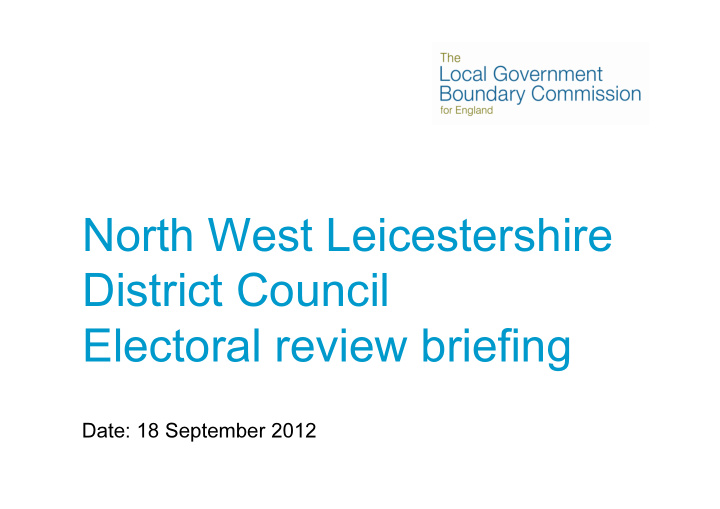



North West Leicestershire District Council Electoral review briefing Date: 18 September 2012
Introductions • Danny Edwards – Review Manager 2
• We are independent of Government and political About us parties, and directly accountable to Parliament through the Speaker’s Committee • We are responsible for reviewing local authority electoral arrangements, administrative boundaries and structure • Our recommendations for this review will be implemented by Parliament 3
• Explain the Review Process Purpose of - Our statutory criteria Presentation - How we develop our recommendations - Consultation – involvement • What will the Council need to do throughout the review • What you can expect from us and how we can assist you 4
• Our aim is to ensure that each councillor represents approximately the same number of electors Why are we • Our criteria for starting a review is where: conducting an – 30% of wards have an electoral variance of more electoral review than 10% from the average and / or – One ward has an electoral variance more than 30% of West from the average Leicestershire? • We are reviewing North West Leicestershire following a request from the Council for the a uniform pattern of single-member wards. 5
• Review will decide the pattern of wards for the entire Scope of the district – not just wards where there are levels of electoral inequality review • We will decide: – Total number of councillors (council size) – Number of wards – Names of wards – Boundaries of wards • Also have regard to: – Electoral cycles 7
How wards may change: original wards 8
How wards may change: new wards 9
• Electoral equality – Optimum number of electors per councillor – Five year forecast Statutory – In time for next election criteria • Community identity – Parishes as building blocks – Strong boundaries – Location of public facilities – Tell us ward by ward basis • Effective and convenient local government – Coherent wards with good internal transport links 10
• Parliamentary constituency boundaries, which are drawn by the Boundary Commission for England What we • Current borough wards cannot consider • Local political implications of recommendations • School catchment areas • Postcodes or addresses • Polling districts 11
• We cannot create or abolish parishes, or amend their Rules relating boundaries to parishes • If we divide a parish between borough wards, we must create parish wards • We can change parish electoral arrangements only as a direct consequence of our borough ward proposals 12
• What is council size (number of councillors Council size: elected) The Commission’s • Starting point of review – councillors divided by electorate – optimum cllr:ratio – enables everyone approach proposals for warding patterns • Commission will make final decision on council size 13
• Preliminary stage: – council size discussion • Do you have the right council size? • What are the demands of time on elected Review process members? Could the council operate more effectively with a different number? • Opportunity for council to consider political management and governance • Consideration of members representative role • Effective representation of constituents • Council size consultation 14
• Further information gathering (10 weeks) Review process – Invite warding patterns from council, public, parish councils, everybody who takes an interest – Welcome proposals for whole borough or just a few parishes – Commission tours area • Commission publishes draft recommendations – Posters provided to parish councils to publicise review • Open consultation on draft recommendations (10 – 12 weeks) • Commission publishes final recommendations • Once recommendations finalised, the order will be laid in Parliament for 40 sitting days before the order can be made. 15
• Representations which support are as important Effective as those which oppose Representations • Representations will be judged on the quality of argument and evidence presented • Effective representations will: – Suggest an alternative as well as setting out an objection – Take account of statutory requirements – Consider consequences of alternative across widest possible area 16
• Detailed rationale for council size. What • Accurate electorate figures and robust methodology characterises a when forecasting expected growth good review • Scheme coming forward which gives good electoral equality while balancing other statutory criteria, has cross-party support, has been consulted on locally • Highly important to involve as many groups/individuals as possible at as early a stage as possible • Where cannot secure consensus across a scheme, tell us where there is agreement • Representations based on evidence, not just assertion 17
Contact Review Manager: Danny Edwards details email: daniel.edwards@lgbce.org.uk Tel: 020 7664 8536 Website: www.lgbce.org.uk 18
Recommend
More recommend